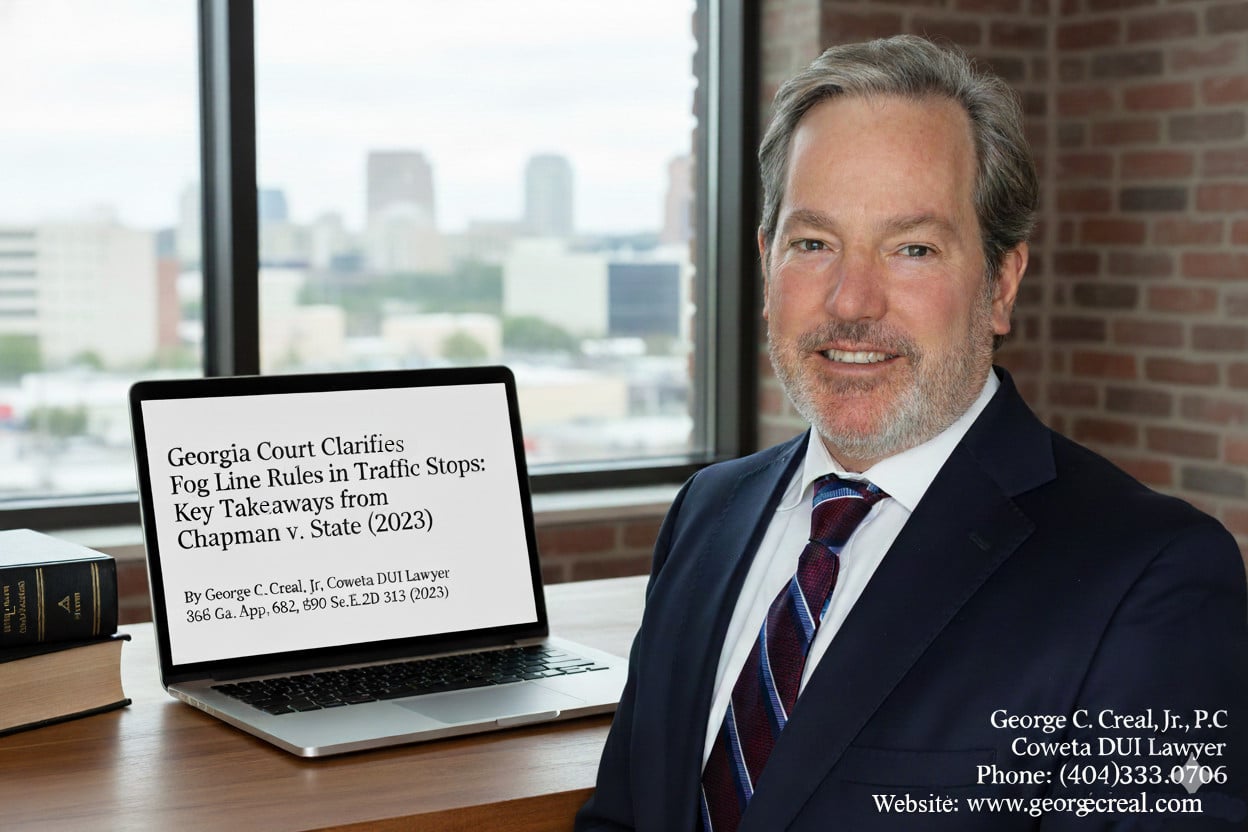
The Facts: A Traffic Stop Turns into a Drug Bust
On November 29, 2018, Coweta County Sheriff's officers received an anonymous tip that Chapman would be driving south on Highway 70 in a silver Ford Mustang or white Ford F-150, carrying methamphetamine toward Roscoe General Store. Officer Trent Hastings spotted a silver Mustang heading that way and claimed he saw the passenger-side tires "travel well onto" the fog line (the white line marking the edge of the lane).
Hastings activated his lights, but Chapman didn't pull over immediately, citing no safe spot due to a curve. Officers interpreted his hand gestures as a potential sign of fleeing and forced him to stop by pulling in front. With guns drawn (quickly re-holstered), they ordered Chapman out, patted him down with his consent, and asked if he had anything illegal. Less than two minutes in, Chapman admitted to having methamphetamine. Officers then detained him, read his Miranda rights, searched the car, and found 55 grams in the console—enough for a trafficking charge under OCGA § 16-13-31(e).
Chapman moved to suppress the evidence, arguing an illegal stop, lack of suspicion for a drug probe, and Miranda violations. The trial court denied it, a jury convicted him, and he got 20 years. On appeal, the Court of Appeals affirmed.
Key Ruling 1: Touching the Fog Line Isn't a Traffic Violation—But the Stop Was Still Valid
Chapman argued the stop lacked reasonable suspicion because merely touching (not crossing) the fog line doesn't violate Georgia's "failure to maintain lane" law (OCGA § 40-6-48(1)). This statute requires drivers to stay "as nearly as practicable entirely within a single lane" unless safe to move.
The court agreed: Driving on but not over the fog line isn't a violation. They cited no prior Georgia cases upholding convictions for just touching the line, and referenced a recent case Lute v. State (368 Ga. App. 70, 889 S.E.2d 195 (2023)) where weaving within the lane and touching lines wasn't enough. Even a federal court had ruled similarly.
However, the stop stood because the officer's mistake was "objectively reasonable." Georgia law was ambiguous on what counts as a "lane" (the Code doesn't define it clearly, and fog lines aren't explicitly addressed). Until this decision (and Lute), officers could reasonably believe touching the line violated the law. This echoes U.S. Supreme Court precedent in Heien v. North Carolina (574 U.S. 54 (2014)), where reasonable mistakes of law can justify stops.
Takeaway for Drivers: If you're pulled over for "weaving within your lane" or touching the fog line, this ruling strengthens suppression arguments. But ambiguity in the law might still validate the stop except for touching the lane lines which is unambiguous moving forward—consult a lawyer to challenge it.
Key Ruling 2: Anonymous Tip + Corroboration = Reasonable Suspicion for Drug Investigation
Even if the initial stop was okay, Chapman claimed officers ditched the traffic inquiry and jumped straight to drugs without justification. The court disagreed, classifying this as a valid "tier-two" encounter (brief seizure requiring reasonable suspicion of crime).
Anonymous tips alone aren't enough, but here it predicted specifics: Chapman's vehicle, direction, and destination. Officers corroborated this by spotting him en route. Plus, his delayed stop and hand gestures (seen as flight prep based on the officer's experience) added suspicion. Under Alabama v. White, this gave the tip reliability, justifying questions about illegal items.
Implications for DUI Cases: In DUIs, stops often start with minor traffic issues but pivot to impairment probes. If there's an uncorroborated tip (e.g., "swerving driver"), it might not hold up. This case shows how quickly things escalate—always know your rights during stops.
Key Ruling 3: No Miranda Violation—Questioning Wasn't "Custodial" Yet
Chapman said he was in custody from the start (guns drawn, ordered out), so asking about illegal items without Miranda warnings violated his rights. The court said no: Miranda kicks in only for "custodial interrogation," where a reasonable person feels restrained like in a formal arrest.
Here, the stop was in daylight on a public road, guns were holstered quickly, no force was used, and Chapman stood unrestrained. The key question ("Do you have anything illegal?") came under three minutes in, during a consensual pat-down. Only after his admission did they cuff him and Mirandize. The court compared it to U.S. v. Acosta, where similar tactics didn't trigger custody.
Why It Matters: In traffic stops, you're detained but not always "in custody." Admissions before Miranda can be used against you if the situation feels temporary. If officers overstep, evidence might get suppressed—critical in DUI breath/blood test refusals or field sobriety.
Protecting Your Rights in Georgia Traffic Stops
Chapman v. State refines the rules on fog line stops, tipping the scales toward drivers by clarifying that touching the line isn't illegal. Yet it upholds stops based on reasonable mistakes and corroborated tips, reminding us how fine the line is in these cases. For DUI clients in Coweta County, this reinforces the importance of challenging every aspect of a stop—from suspicion to questioning.
If you've been stopped for a traffic violation that led to DUI or drug charges, don't go it alone. As a Coweta DUI lawyer, I've successfully suppressed evidence in similar scenarios. Contact George Creal today for a free consultation—let's review your case and fight for your rights. Stay safe on the roads!

